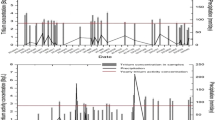Abstract
This paper discusses the spatiotemporal variation in atmospheric tritiated water (HTO) concentration near the Fukushima Daiichi Nuclear Power Plant (FDNPP) from 2019 to 2021. The monthly HTO concentrations varied seasonally from below the detection limit to 280.4 mBq m− 3. The HTO concentrations were decreased with the distance from the FDNPP to the pre-accident level at 5 km. The concentration was related to northeasterly wind, suggesting a potential atmospheric release of HTO vapor from the FDNPP. Our results highlight the need for detailed studies to comprehend HTO transport in atmospheric environments.
Article highlights
Post-accident level of tritiated water (HTO) vapor in the atmosphere around Fukushima Daiichi Nuclear Power Plant (FDNPP).
Decrease in atmospheric HTO concentration as the distance between the FDNPP and the observation points increased.
Study findings useful for estimating the effects of future treated water disposal in the oceans from the FDNPP.




Similar content being viewed by others
References
Boyer C, Vichot L, Fromm M et al (2009) Tritium in plants: A review of current knowledge. Environ Exp Bot 67:34–51. https://doi.org/10.1016/j.envexpbot.2009.06.008
United Nations Scientific Committee on the Effects of Atomic Radiation (2008) Sources and effects of ionizing radiation: United Nations Scientific Committee on the Effects of Atomic Radiation (UNSCEAR). 2008 report, Volume I: Sources Report to the General Assembly, with scientific annexes. United Nations, New York
United Nations Scientific Committee on the Effects of Atomic Radiation (2000) Sources and effects of ionizing radiation: United Nations Scientific Committee on the Effects of Atomic Radiation (UNSCEAR). 2000 report, Volume I-Report to the General Assembly, with scientific annexes. United Nations, New York
Connan O, Hébert D, Solier L, Maro L, Pellerin D, Voiseux G et al (2017) Atmospheric tritium concentrations under influence of AREVA NC La Hague reprocessing plant (France) and background levels. J Environ Radioact 177:184–193. https://doi.org/10.1016/j.jenvrad.2017.06.015
Miljević N, Šipka V, Žujić A, Golobočanin D (2000) Tritium around the Vinca Institute of Nuclear Sciences. J Environ Radioact 48:303–315. https://doi.org/10.1016/S0265-931X(99)00082-X
Akata N, Kakiuchi H, Tanaka M, Shima N, Shiroma Y, Tokonami S et al (2018) Development of rapid sampling system of atmospheric water vapor for tritium measurement. Plasma Fusion Res 13:3405064–3405064. https://doi.org/10.1585/pfr.13.3405064
Steinhauser G (2014) Fukushima’s Forgotten Radionuclides: A Review of the Understudied Radioactive Emissions. Environ Sci Technol 48:4649–4663. https://doi.org/10.1021/es405654c
Kakiuchi H, Akata N, Hasegawa H et al (2012) Concentration of 3H in plants around Fukushima Dai-ichi Nuclear Power Station. Sci Rep 2:947. https://doi.org/10.1038/srep00947
Hirao S, Kakiuchi H (2021) Investigation of atmospheric tritiated water vapor level around the Fukushima Daiichi nuclear power plant. Fusion Eng Des 171. https://doi.org/10.1016/j.fusengdes.2021.112556
Kashiwaya K, Muto Y, Kubo T, Ikawa R, Nakaya S, Koike K et al (2017) Spatial variations of tritium concentrations in groundwater collected in the southern coastal region of Fukushima, Japan, after the nuclear accident. Sci Rep 7:12578. https://doi.org/10.1038/s41598-017-12840-3
Matsumoto T, Maruoka T, Shimoda G, Obata H, Kagi H, Suzuki K et al (2013) Tritium in Japanese precipitation following the March 2011 Fukushima Daiichi Nuclear Plant accident. Sci Total Environ 445–446:365–370. https://doi.org/10.1016/j.scitotenv.2012.12.069
Ueda S, Hasegawa H, Kakiuchi H, Ochiai S, Akata N, Hisamatsu S (2015) Nuclear accident-derived (3)H in river water of Fukushima Prefecture during 2011–2014. J Environ Radioact 146:102–109. https://doi.org/10.1016/j.jenvrad.2015.04.014
Querfeld R, Pasi AE, Shozugawa K, Vockenhuber C, Synal HA, Steier P et al (2019) Radionuclides in surface waters around the damaged Fukushima Daiichi NPP one month after the accident: Evidence of significant tritium release into the environment. Sci Total Environ 689:451–456. https://doi.org/10.1016/j.scitotenv.2019.06.362
Japan Atmoc Energy Agency (JAEA) (2022) Database for Radioactive Substance Monitoring Data. https://emdb.jaea.go.jp/emdb/. Accessed 1st
Akata N, Kakiuchi H, Kanno K, Shima N, Hisamatsu S (2011) Determination of the atmospheric HTO concentration around the nuclear fuel reprocessing plant in Rokkasho by using a passive type sampler. Fusion Sci Technol 60:1292–1295. https://doi.org/10.13182/FST11-A12667
Iida T, Yokoyama S, Fukuda H, Ikebe Y (1995) A simple passive method of collecting water vapour for environmental tritium monitoring. Radiat Prot Dosim 58:23–27. https://doi.org/10.1093/oxfordjournals.rpd.a082593
ISO (2010) ISO 11929 Standard. Determination of the Characteristic Limits (Decision Threshold, Detection Limit and Limits of the Confidence Interval) for Measurements of Ionizing Radiation – Fundamentals and Application
Secretariat of the Nuclear Regulation Authority (2022) Japanese Environmental Radioactivity and Radiation. https://www.kankyo-hoshano.go.jp/data/database/. Accessed 1st
Tagomori H, Tamari T, Kawamura H(2016) Tritium activity concentration of water vapor and precipitation Fukushima Prefecture in 2013–2014, Kankyo Kanri. 44:52–54. https://keea.or.jp/pdf/knakyokanri/44/vol_44_08.pdf. Accessed 1st Feb 2022 (in Japanese)
Okai T, Momoshima N, Takashima Y (1999) Variation of atmospheric tritium concentrations in three different chemical forms in Fukuoka, Japan. J Radioanal Nucl Chem 239:527–531. https://doi.org/10.1007/BF02349063
Garland JA (1980) The absorption and evaporation of tritiated water vapor by soil and grassland. Water Air Soil Pollut 13:317–333. https://doi.org/10.1007/BF02145476
Tokyo Electric Power Company Holdings, Inc (2022) Radiation Dose measured at Monitoring Post of Fukushima Daiichi Nuclear Power Station. https://www.tepco.co.jp/en/hd/decommission/data/monitoring/index-e.html. Accessed 1st
Momoshima N, Okai T, Inoue M, Takashima Y (1987) Tritium monitoring around a nuclear power station in normal operation. Int J Radiat Appl Instrumentation Part A Appl Radiat Isot 38:263–267. https://doi.org/10.1016/0883-2889(87)90036-0
Nuclear Regulation Authority, Monitoring of sea water. https://radioactivity.nsr.go.jp/en/list/205/list-1.html. Accessed 1st Feb 2022
International Atomic Energy Agency (1986) Atmospheric dispersion models for application in relation to radionuclide releases - A Review, IAEA-TECDOC-379. IAEA, Vienna
Acknowledgements
We are grateful to all the participants in our research, particularly the staff members at the municipal government of Okuma and the owners of the sites for permitting access. We thank the anonymous reviewers for their constructive reviews and suggestions. This work was partly supported by the NIFS collaboration research programs, NIFS18KOCA003 and NIFS21KOCA005, JSPS KAKENHI Grant Number JP21H03607 and Fukushima University.
Author information
Authors and Affiliations
Corresponding author
Additional information
Publisher’s note
Springer Nature remains neutral with regard to jurisdictional claims in published maps and institutional affiliations.
Rights and permissions
About this article
Cite this article
Hirao, S., Kakiuchi, H., Akata, N. et al. Characterization of atmospheric tritiated water concentration in the vicinity of the fukushima daiichi nuclear power plant. J Radioanal Nucl Chem 331, 3077–3083 (2022). https://doi.org/10.1007/s10967-022-08374-2
Received:
Accepted:
Published:
Issue Date:
DOI: https://doi.org/10.1007/s10967-022-08374-2




